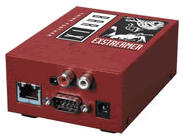German sound and audio works TerraTec Electronic is offering a new professional preamplifier/converter for PC-based workstations. The EWS MIC8 AudioSystem is a standard 19-inch rack unit with eight high-quality balanced line and microphone inputs, and eight balanced outputs. It should be available in late January 2003.

Other features of the MIC8 include 48V phantom power for condenser mics, a low-cut filter per input channel, ADAT interface, EWS88 PCI card including 4 meter connection cable, 24-bit S/PDIF, 2 MIDI ports, WordClock I/O and flexible routing of all sources. The EWS MIC 8 will be available after the NAMM.
The core 8-channel microphone preamp of the EWS MIC8 AudioSystem was developed by TerraTec in close cooperation with SPL (SoundPerformanceLab) Germany. It can be used as a stand-alone device – for example, as a microphone preamplifier, or as 24-bit/96-kHz AD/DA converter in connection with ADAT devices or cards – or connected to a PC-based workstation through the available TerraTec EWS88 PCI card.
TerraTec also introduced a lower-priced companion product at NAMM, based on the MIC8 19″ module. The AudioSystem EWS MIC2 offers all of the features of the MIC8, including the 8 balanced analog inputs and outputs, but with only two microphone preamps rather than eight.
Each of the new rack units is available individually, or in a bundle (MIC8+, MIC2+) with the EWS88 PCI card and connection cable.
Key Features of the MIC8 & MIC2
- 19″ rack mounted external module for EWS88 PCI card interface (hardware version 2.0 or later), or any ADAT interface cards
- 24 bit/96 kHz A/D converters with 105 dB (A) SNR
- 24 bit/96 kHz D/A converters with 106 dB (A) SNR
- 8 channel balanced analog I/O, XLR and 6.3 mm stereo jack
- 8 gain controls on front side for analog inputs (20 dB range)
- 8 input signal and clip LEDs on front side
- 2 XLR balanced Mic In’s on front side, alternatively to input 7 and 8 (auto priority)
- Input switchable between Mic and Line/Instrument
- 8 (2 with MIC2) high quality microphone amplifiers, developed in co-operation with SPL Germany
- Direct Out setting for all analog channels on front side (monitoring)
- Phase, low-cut and mute settings for each channel
- 48 Volt phantom power
- High quality headphone DAC and amplifier for monitoring the mixed signal
- Internal power supply
- Integrated ADAT interface (Light-Pipe)
- TOS-Link interface for ADAT or S/PDIF
- Up to 8 ADAT channels and audio channels can be mixed
- 2 separate MIDI-interfaces (with EWS88 PCI card)
- WordClock I/O
- +4/-10 dB setting
- Stand-alone operation mode (microphone preamp, ADAT interface, DI-Box)
 Exstreamer is now available online through Barix’s U.S. Master distributor,
Exstreamer is now available online through Barix’s U.S. Master distributor,